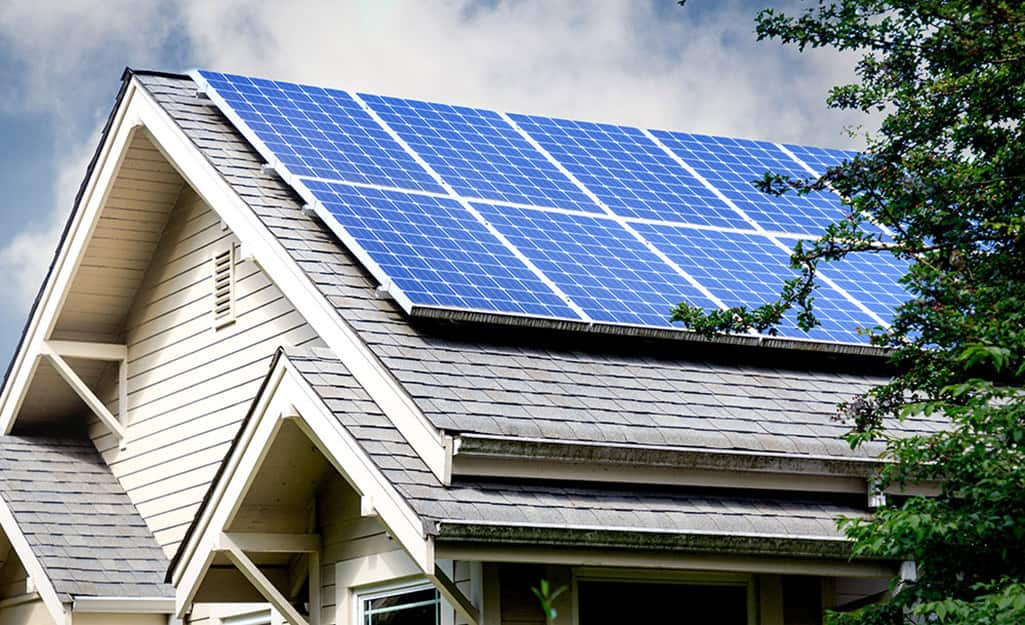Buying Guide
Solar Panel Buying Guide
Enjoy clean, infinitely renewable power from the sun when you utilize solar panels on your home, business and/or RV. This guide will explain the key components of a solar power system, the differences among the main types of solar panels and whether you should choose professional or DIY installation.
Main Components of Solar Power Systems

The best solar panels for you will depend on your budget and the amount of light that’s available in your location. Knowing the components of a solar power system can help you understand how the types of solar panels work.
There are three main components in a solar power system:
Solar Panels: The main role of a solar panel is to generate electrons when exposed to sunlight, which then helps produce a flow of electricity for your home or office. Solar panels don’t release fumes and don’t have greenhouse gases or carbon emissions.
The amount of electricity solar panels produce from sunlight is referred to as solar efficiency. The average efficiency rating is between 15 percent and 17 percent, but high-end models can reach above 20 percent.
Inverters: Standard home appliances use alternating current (AC) electricity to operate. Inverters take the direct current (DC) electricity produced by solar panels and convert it into AC electricity.
There are two types of inverters: string inverters and microinverters. A string inverter is attached to a wall, and all the solar panels connect to it. A microinverter is attached behind each solar panel. Microinverters offer more energy production, but they cost more than string inverters. Most solar panel kits feature one of these two inverters, as well as essential solar power accessories such as batteries, solar battery chargers, charge controllers and cables.
Mounting Racks: The roof is the most common place to install your solar panels. They can also be mounted on poles or on the ground. Wherever your solar panels are located, mounting racks help you secure them.
Fixed mounting racks remain in the same pre-set position. Fixed mounting racks can be less costly to install. They often require less upkeep.
Tracking mounts move or can be adjusted to follow the sun’s changing path. Consider mounting racks that can be adjusted for height and angle. This helps you get the most out your solar panels as the angle of the sun changes throughout the year.
Monocrystalline Solar Panels

Most solar panels are constructed from oney of three types of solar cells: monocrystalline, polycrystalline or amorphous silicon. Silicon is used for different types of solar panels because it’s a durable material that’s highly efficient and easily accessible.
Monocrystalline solar panels are the most common and efficient types of solar panels available. Due to the silicon’s high purity, these panels excel at producing electricity and boast some of the highest efficiency ratings on the market.
Monocrystalline panels also take up less space, handle high temperatures well and have an impressive lifespan. Some manufacturers offer a 25-year warranty on the panels. These benefits come at a high price point, so consider how much you’re willing to spend if you’re interested in monocrystalline solar panels.
Polycrystalline Solar Panels

Among the types of solar panels, polycrystalline solar panels are much more efficient. A streamlined manufacturing process ultimately makes these panels less costly than monocrystalline solar panels.
While polycrystalline solar panels are more affordable, they don’t generate as much power as monocrystalline solar panels do. Additionally, polycrystalline solar panels tend to be larger and have a slightly shorter lifespan than their monocrystalline counterparts. They’re also not as effective in high-temperature or low-light situations.
Amorphous Solar Panels

Amorphous solar panels are made from a thin layer of silicon, which allows them to be more flexible and lightweight than monocrystalline and polycrystalline panels. Another benefit is that they perform well in high temperatures. They’re also one of the best solar panels for low-light conditions because they can absorb a wider range of the light spectrum.
Amorphous solar panels, however, are the least efficient since they take up twice as much space to deliver the same amount of power as monocrystalline panels. Their lifespan is also shorter than monocrystalline and polycrystalline panels.
Professional vs. Do-It-Yourself Solar Installation

After deciding on the best solar panels for you, it’s time to figure out how you want to install them. DIY installation may be less costly, but can be quite complicated. With professional installation, you not only get better quality panels, but also the peace of mind that comes with knowing that your solar panel system is properly set up.
The Home Depot offers local solar power installation by experts who are licensed, insured and have passed a background check.
